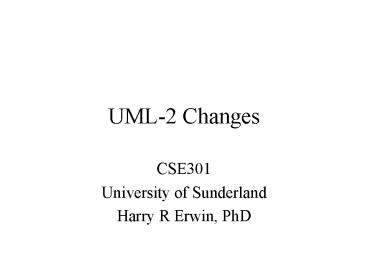UML-2 Changes - PowerPoint PPT Presentation
1 / 22
Title:
UML-2 Changes
Description:
... al., 2004, UML 2 Toolkit, OMG ... UML 2 Activity Diagrams. Describes a sequential ... UML 2 State Machine Diagrams. Used only when a class or subsystem ... – PowerPoint PPT presentation
Number of Views:21
Avg rating:3.0/5.0
Title: UML-2 Changes
1
UML-2 Changes
- CSE301
- University of Sunderland
- Harry R Erwin, PhD
2
Resources
- Eriksson, H-E., et al., 2004, UML 2 Toolkit, OMG
Press, Wiley. - Pilone, D., with Neil Pitman, 2005, UML 2.0 in a
Nutshell, OReilly. - http//www.uml.org/
- http//www.agilemodeling.com/
- http//en.wikipedia.org/wiki/Unified_Modeling_Lang
uage - http//www.eclipse.org/modeling/mdt/?projectuml2
3
Major Changes in UML 2
- Use Cases
- Activity Diagrams
- State Machine Diagrams
- Sequence Diagrams
- Communication Diagrams
- Interaction Overview Diagrams
- Timing Diagrams
4
A UML 2 Use-Case Diagram
G1 Section
Personnel
G2 Section
Intelligence
Commander
CoS
G3 Section
Operations
G4 Section
Logistics
5
More Details in Use Cases
Extension case
Actor Generalization
ltltextendgtgt
Direction of the interaction
General Case ltltextension pointsgtgt Detailed case
ltltincludegtgt
Use Case Generalization
Included Use Case
6
Use Case Details
- Description still usually textual.
- Use cases are initiated by actors and provide
value to them. - Use cases should be complete.
- Use activity diagrams to clarify the flow.
- Use cases can be
- Generalized (new)
- Extended
- Included (was used)
7
New UML 2 Class Diagrams
An Entity Class
ltltentitygtgt An Entity Class
An Entity Class
A Control Class
ltltcontrolgtgt A Control Class
A Control Class
A Boundary Class
ltltboundarygtgt A Boundary Class
A Boundary Class
8
Interfaces and Ports
Storable
Runnable
Interface Provided
Port
Runnable
Required Interface
9
Diagramming Composite Structures
10
Collaboration Use Case
Represents a dynamic use case
Name
Name
11
Implementing Attributes in a Model
Attribute Type UML Type Java I/F
Inline or relationship As noted Object
Count Array Array
Unordered/dups Bag Collection
Ordered/dups Sequence List
Unordered/uniq Set Set
Ordered/uniq OrderedSet SortedSet
12
Templates
ElementType
Type
13
Packages
Name
Package Name
14
UML 2 Activity Diagrams
- Describes a sequential flow of actions. In some
ways similar to a state machine, but now a
first-class construct. - Can be used to diagram general process workflows,
use cases, and detailed control flows. Very
valuable when you model a business. - Based on Petri Nets (qv).
- Resembles old-fashioned flow charts, but often
contain swim-lanes, called activity partitions,
that describe what specific classes or subsystems
do.
15
UML 2 Activity Diagram Changes
- No longer emphasizes transitions (as a super
state machine diagram). More concerned with token
flow along activity edges.
16
Activity Diagram Appearence
Also used for interaction overview diagrams
Name
Name
Final Node
Initial Node
17
UML 2 State Machine Diagrams
- Used only when a class or subsystem changes its
behaviour. A complement to a class or object
diagram. - Two kinds of state machines
- A behavioural state machine describing the life
cycle of a class or subsystem. Typically, the
class or subsystem contains a polymorphic
reference whose current subclass instance defines
the behaviour. - A protocol state machine documenting the protocol
for other subsystems to interact with an
interface or port. (This is the traditional role
of a state machine.)
18
UML 2 Sequence Diagrams
- Describe how multiple classes or subsystems
interact dynamically via message passing. Similar
in some ways to activity diagrams, but emphasize
the messages. Most commonly used interaction
diagram. - Often derived from Use Case Analysis (just like
activity diagrams). - Usually contain vertical swim-lanes, each
corresponding to an individual object/actor. - Messages are shown passing between swim-lanes.
19
UML Sequence Diagram Changes
- Now has fragments allowing more complex options
to be diagrammed. Also supports reuse of elements.
20
UML 2 Communication Diagrams
- Were called Collaboration Diagrams in UML 1.
- Show the messages and the objects in their
relationships (the context). Contains the same
information as sequence diagrams, but formatted
differently. Very useful for analysing class and
object diagrams. - The full set of communication diagrams for a
system should map directly onto the object
associations of the system. When this is
important to know, use communication diagrams
rather than sequence diagrams.
21
UML 2 Interaction Overview Diagrams
- Introduced in UML 2.
- Top-level description of the main flow of
interactions. - Basically an activity diagram with the main nodes
individually documented using separate sequence
(or other) diagrams. - Major step in user-oriented design.
22
UML 2 Timing Diagrams
- Introduced in UML 2.
- Specialized for real-time systems, using a
precise time axis. - MSc-level topic.































